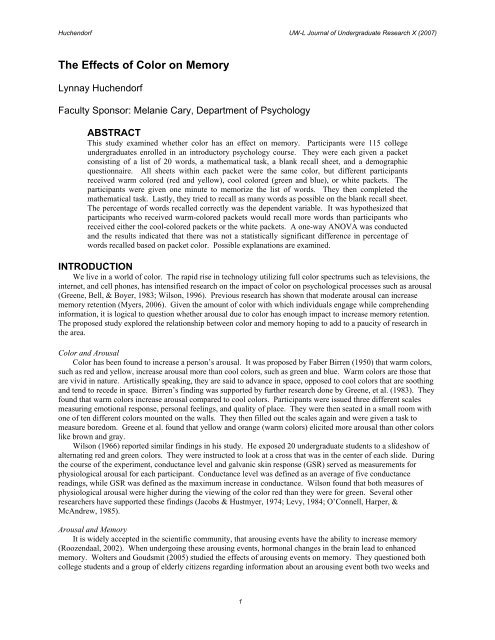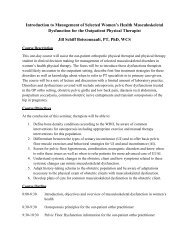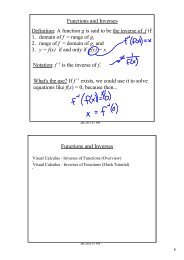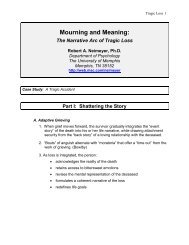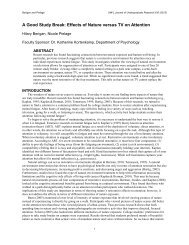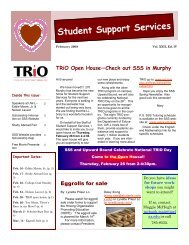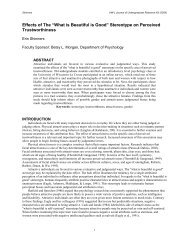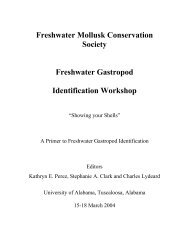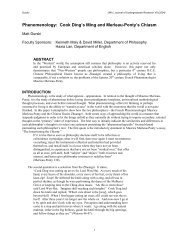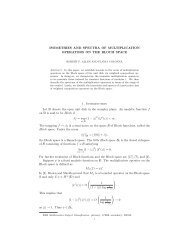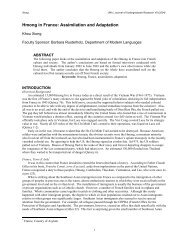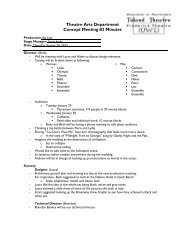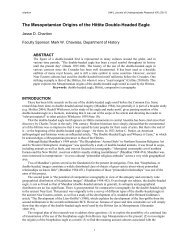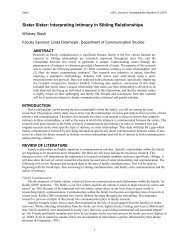The Effects of Color on Memory - University of Wisconsin La Crosse
The Effects of Color on Memory - University of Wisconsin La Crosse
The Effects of Color on Memory - University of Wisconsin La Crosse
You also want an ePaper? Increase the reach of your titles
YUMPU automatically turns print PDFs into web optimized ePapers that Google loves.
Huchendorf UW-L Journal <str<strong>on</strong>g>of</str<strong>on</strong>g> Undergraduate Research X (2007)<br />
<str<strong>on</strong>g>The</str<strong>on</strong>g> <str<strong>on</strong>g>Effects</str<strong>on</strong>g> <str<strong>on</strong>g>of</str<strong>on</strong>g> <str<strong>on</strong>g>Color</str<strong>on</strong>g> <strong>on</strong> <strong>Memory</strong><br />
Lynnay Huchendorf<br />
Faculty Sp<strong>on</strong>sor: Melanie Cary, Department <str<strong>on</strong>g>of</str<strong>on</strong>g> Psychology<br />
ABSTRACT<br />
This study examined whether color has an effect <strong>on</strong> memory. Participants were 115 college<br />
undergraduates enrolled in an introductory psychology course. <str<strong>on</strong>g>The</str<strong>on</strong>g>y were each given a packet<br />
c<strong>on</strong>sisting <str<strong>on</strong>g>of</str<strong>on</strong>g> a list <str<strong>on</strong>g>of</str<strong>on</strong>g> 20 words, a mathematical task, a blank recall sheet, and a demographic<br />
questi<strong>on</strong>naire. All sheets within each packet were the same color, but different participants<br />
received warm colored (red and yellow), cool colored (green and blue), or white packets. <str<strong>on</strong>g>The</str<strong>on</strong>g><br />
participants were given <strong>on</strong>e minute to memorize the list <str<strong>on</strong>g>of</str<strong>on</strong>g> words. <str<strong>on</strong>g>The</str<strong>on</strong>g>y then completed the<br />
mathematical task. <strong>La</strong>stly, they tried to recall as many words as possible <strong>on</strong> the blank recall sheet.<br />
<str<strong>on</strong>g>The</str<strong>on</strong>g> percentage <str<strong>on</strong>g>of</str<strong>on</strong>g> words recalled correctly was the dependent variable. It was hypothesized that<br />
participants who received warm-colored packets would recall more words than participants who<br />
received either the cool-colored packets or the white packets. A <strong>on</strong>e-way ANOVA was c<strong>on</strong>ducted<br />
and the results indicated that there was not a statistically significant difference in percentage <str<strong>on</strong>g>of</str<strong>on</strong>g><br />
words recalled based <strong>on</strong> packet color. Possible explanati<strong>on</strong>s are examined.<br />
INTRODUCTION<br />
We live in a world <str<strong>on</strong>g>of</str<strong>on</strong>g> color. <str<strong>on</strong>g>The</str<strong>on</strong>g> rapid rise in technology utilizing full color spectrums such as televisi<strong>on</strong>s, the<br />
internet, and cell ph<strong>on</strong>es, has intensified research <strong>on</strong> the impact <str<strong>on</strong>g>of</str<strong>on</strong>g> color <strong>on</strong> psychological processes such as arousal<br />
(Greene, Bell, & Boyer, 1983; Wils<strong>on</strong>, 1996). Previous research has shown that moderate arousal can increase<br />
memory retenti<strong>on</strong> (Myers, 2006). Given the amount <str<strong>on</strong>g>of</str<strong>on</strong>g> color with which individuals engage while comprehending<br />
informati<strong>on</strong>, it is logical to questi<strong>on</strong> whether arousal due to color has enough impact to increase memory retenti<strong>on</strong>.<br />
<str<strong>on</strong>g>The</str<strong>on</strong>g> proposed study explored the relati<strong>on</strong>ship between color and memory hoping to add to a paucity <str<strong>on</strong>g>of</str<strong>on</strong>g> research in<br />
the area.<br />
<str<strong>on</strong>g>Color</str<strong>on</strong>g> and Arousal<br />
<str<strong>on</strong>g>Color</str<strong>on</strong>g> has been found to increase a pers<strong>on</strong>’s arousal. It was proposed by Faber Birren (1950) that warm colors,<br />
such as red and yellow, increase arousal more than cool colors, such as green and blue. Warm colors are those that<br />
are vivid in nature. Artistically speaking, they are said to advance in space, opposed to cool colors that are soothing<br />
and tend to recede in space. Birren’s finding was supported by further research d<strong>on</strong>e by Greene, et al. (1983). <str<strong>on</strong>g>The</str<strong>on</strong>g>y<br />
found that warm colors increase arousal compared to cool colors. Participants were issued three different scales<br />
measuring emoti<strong>on</strong>al resp<strong>on</strong>se, pers<strong>on</strong>al feelings, and quality <str<strong>on</strong>g>of</str<strong>on</strong>g> place. <str<strong>on</strong>g>The</str<strong>on</strong>g>y were then seated in a small room with<br />
<strong>on</strong>e <str<strong>on</strong>g>of</str<strong>on</strong>g> ten different colors mounted <strong>on</strong> the walls. <str<strong>on</strong>g>The</str<strong>on</strong>g>y then filled out the scales again and were given a task to<br />
measure boredom. Greene et al. found that yellow and orange (warm colors) elicited more arousal than other colors<br />
like brown and gray.<br />
Wils<strong>on</strong> (1966) reported similar findings in his study. He exposed 20 undergraduate students to a slideshow <str<strong>on</strong>g>of</str<strong>on</strong>g><br />
alternating red and green colors. <str<strong>on</strong>g>The</str<strong>on</strong>g>y were instructed to look at a cross that was in the center <str<strong>on</strong>g>of</str<strong>on</strong>g> each slide. During<br />
the course <str<strong>on</strong>g>of</str<strong>on</strong>g> the experiment, c<strong>on</strong>ductance level and galvanic skin resp<strong>on</strong>se (GSR) served as measurements for<br />
physiological arousal for each participant. C<strong>on</strong>ductance level was defined as an average <str<strong>on</strong>g>of</str<strong>on</strong>g> five c<strong>on</strong>ductance<br />
readings, while GSR was defined as the maximum increase in c<strong>on</strong>ductance. Wils<strong>on</strong> found that both measures <str<strong>on</strong>g>of</str<strong>on</strong>g><br />
physiological arousal were higher during the viewing <str<strong>on</strong>g>of</str<strong>on</strong>g> the color red than they were for green. Several other<br />
researchers have supported these findings (Jacobs & Hustmyer, 1974; Levy, 1984; O’C<strong>on</strong>nell, Harper, &<br />
McAndrew, 1985).<br />
Arousal and <strong>Memory</strong><br />
It is widely accepted in the scientific community, that arousing events have the ability to increase memory<br />
(Roozendaal, 2002). When undergoing these arousing events, horm<strong>on</strong>al changes in the brain lead to enhanced<br />
memory. Wolters and Goudsmit (2005) studied the effects <str<strong>on</strong>g>of</str<strong>on</strong>g> arousing events <strong>on</strong> memory. <str<strong>on</strong>g>The</str<strong>on</strong>g>y questi<strong>on</strong>ed both<br />
college students and a group <str<strong>on</strong>g>of</str<strong>on</strong>g> elderly citizens regarding informati<strong>on</strong> about an arousing event both two weeks and<br />
1
Huchendorf UW-L Journal <str<strong>on</strong>g>of</str<strong>on</strong>g> Undergraduate Research X (2007)<br />
two m<strong>on</strong>ths after the event. <str<strong>on</strong>g>The</str<strong>on</strong>g>y found that regardless <str<strong>on</strong>g>of</str<strong>on</strong>g> the age or time period, both groups showed a high level <str<strong>on</strong>g>of</str<strong>on</strong>g><br />
recall for details <str<strong>on</strong>g>of</str<strong>on</strong>g> the event. In additi<strong>on</strong>, many participants described the memories as “very vivid”.<br />
While the Wolters and Goudsmit (2005) study showed that arousal can increase memory, the event they used<br />
was traumatic and very arousing. <str<strong>on</strong>g>Color</str<strong>on</strong>g>s, <strong>on</strong> the other hand, are not so traumatic. A new study by Otani, Libkuman,<br />
Widner, and Graves (2007) looked at the effects <str<strong>on</strong>g>of</str<strong>on</strong>g> less arousing events <strong>on</strong> memory. Otani et al. (2007) split the<br />
participants into two groups. Both were shown a set <str<strong>on</strong>g>of</str<strong>on</strong>g> slides depicting a story and accompanied by a taped<br />
narrative that described each slide. One set showed arousing c<strong>on</strong>tent, while the other showed neutral c<strong>on</strong>tent.<br />
Otherwise, both were matched as closely as possible for c<strong>on</strong>tent.<br />
After viewing the slideshow, participants rated the show <strong>on</strong> a 9-point scale <str<strong>on</strong>g>of</str<strong>on</strong>g> whether or not they agreed that<br />
the show was emoti<strong>on</strong>al and that their reacti<strong>on</strong> to the show was emoti<strong>on</strong>al. <str<strong>on</strong>g>The</str<strong>on</strong>g>y were then given a filler task to<br />
prevent rehearsal, followed by the recogniti<strong>on</strong> test. Otani et al. (2007) found that the participants appropriately rated<br />
the arousing story as more arousing. More importantly they found that recogniti<strong>on</strong> for the more arousing story was<br />
significantly higher than recogniti<strong>on</strong> for the neutral story.<br />
Both Wolters and Goudsmit’s (2005) study and Otani et al.’s (2007) study indicate that arousing events can<br />
increase memory. C<strong>on</strong>sequently, it is reas<strong>on</strong>able to assume that color can act as a memory aid if the colors used are<br />
emoti<strong>on</strong>ally arousing.<br />
<str<strong>on</strong>g>Color</str<strong>on</strong>g> and <strong>Memory</strong><br />
If color can increase arousal, and arousal can increase memory, then it is possible that we could find that color<br />
can increase memory. In 2006, Spence, W<strong>on</strong>g, Rusan, and Rastegar found just that. In their study, 120 participants<br />
viewed a sequence <str<strong>on</strong>g>of</str<strong>on</strong>g> images <str<strong>on</strong>g>of</str<strong>on</strong>g> natural scenes <strong>on</strong> a computer m<strong>on</strong>itor. <str<strong>on</strong>g>The</str<strong>on</strong>g> participants were either shown colored<br />
scenes or gray scale scenes. <str<strong>on</strong>g>The</str<strong>on</strong>g> same scenes were then shown again, either in color or in gray scale. <str<strong>on</strong>g>The</str<strong>on</strong>g><br />
participants were asked to rate the scenes as old or new. Spence et al. (2006) found that color increased the<br />
recogniti<strong>on</strong> <str<strong>on</strong>g>of</str<strong>on</strong>g> the natural scenes by approximately 5%.<br />
McC<strong>on</strong>nohie (1999) created a slideshow with alphanumeric characters such as a “B” or a “2”. He showed the<br />
slideshow to a classroom <str<strong>on</strong>g>of</str<strong>on</strong>g> middle schoolers and asked them to recall as many characters as they could immediately<br />
after seeing the slideshow and then again an hour later. He repeated this three times, each time using a different<br />
color for the background <str<strong>on</strong>g>of</str<strong>on</strong>g> the slideshow (white, blue, or green). <str<strong>on</strong>g>The</str<strong>on</strong>g> character color for all three slideshows was<br />
black. McC<strong>on</strong>nohie found that the slideshow with the white background resulted in higher retenti<strong>on</strong> rates both<br />
immediately, and <strong>on</strong>e hour after viewing the slideshow. This would be an expected result since blue and green are<br />
both cool colors and therefore w<strong>on</strong>’t have as much <str<strong>on</strong>g>of</str<strong>on</strong>g> an arousing effect as white would.<br />
Although McC<strong>on</strong>nohie’s study more directly examines the effects <str<strong>on</strong>g>of</str<strong>on</strong>g> color <strong>on</strong> memory, the sample size was<br />
relatively small and varied from day to day because a classroom <str<strong>on</strong>g>of</str<strong>on</strong>g> students was used. <str<strong>on</strong>g>The</str<strong>on</strong>g>refore, if any students<br />
were absent, the sample size would have changed. In additi<strong>on</strong>, although much educati<strong>on</strong>al stimulus is electr<strong>on</strong>ic,<br />
many students c<strong>on</strong>tinue to gain informati<strong>on</strong> from paper syllabi, worksheets, and handouts. Finally, this is <strong>on</strong>ly <strong>on</strong>e<br />
study and it did not include any warm colors.<br />
<str<strong>on</strong>g>The</str<strong>on</strong>g> current study looked at the effects <str<strong>on</strong>g>of</str<strong>on</strong>g> colored handouts <strong>on</strong> memory retenti<strong>on</strong> <str<strong>on</strong>g>of</str<strong>on</strong>g> undergraduate college<br />
students. As compared to K-12 studying, collegiate level studying requires more time without guidance from others.<br />
Participants were given either a warm, cool, or white-colored word-list and after a filler-task, were asked to recall as<br />
many words as possible. It was predicted that students who received the warm colors (red and yellow) would recall<br />
more characters correctly than those students who received the cool colors (blue and green) or the students who<br />
received the white sheets due to the arousing effects <str<strong>on</strong>g>of</str<strong>on</strong>g> warm colors.<br />
METHOD<br />
Data collecti<strong>on</strong> took place in the fall <str<strong>on</strong>g>of</str<strong>on</strong>g> 2006. Participants were 115 undergraduate students enrolled in<br />
introductory psychology from the <strong>University</strong> <str<strong>on</strong>g>of</str<strong>on</strong>g> Wisc<strong>on</strong>sin – <strong>La</strong> <strong>Crosse</strong>. <str<strong>on</strong>g>The</str<strong>on</strong>g> <strong>University</strong> <str<strong>on</strong>g>of</str<strong>on</strong>g> Wisc<strong>on</strong>sin – <strong>La</strong> <strong>Crosse</strong> is<br />
a public, Midwestern, medium-sized university. Participants received extra credit for their participati<strong>on</strong>. Informed<br />
c<strong>on</strong>sent was obtained and all participants were asked to provide standard demographic informati<strong>on</strong>.<br />
Participants were randomly assigned into <strong>on</strong>e <str<strong>on</strong>g>of</str<strong>on</strong>g> five color c<strong>on</strong>diti<strong>on</strong>s: two were warm colors, two were cool<br />
colors, and the c<strong>on</strong>trol c<strong>on</strong>diti<strong>on</strong>. <str<strong>on</strong>g>The</str<strong>on</strong>g>re were 19 students in the red color c<strong>on</strong>diti<strong>on</strong>, 15 in the yellow color c<strong>on</strong>diti<strong>on</strong>,<br />
22 in the blue color c<strong>on</strong>diti<strong>on</strong>, 25 in the green color c<strong>on</strong>diti<strong>on</strong>, and 34 in the white c<strong>on</strong>trol c<strong>on</strong>diti<strong>on</strong>. I also<br />
c<strong>on</strong>trolled for English as a first language and color-blindness. I wanted all students to have English as their first<br />
language so there were no differing interpretati<strong>on</strong>s <strong>on</strong> the instructi<strong>on</strong>s given.<br />
Each participant received a packet. <str<strong>on</strong>g>The</str<strong>on</strong>g> first page <str<strong>on</strong>g>of</str<strong>on</strong>g> the packet had a list <str<strong>on</strong>g>of</str<strong>on</strong>g> twenty comm<strong>on</strong> 1-3 syllable nouns,<br />
such as chair and butt<strong>on</strong>. Participants were instructed that they would be given <strong>on</strong>e minute to study these words.<br />
2
Huchendorf UW-L Journal <str<strong>on</strong>g>of</str<strong>on</strong>g> Undergraduate Research X (2007)<br />
After study, they were then asked to turn the page and work <strong>on</strong> a 3-digit multiplicati<strong>on</strong> task for <strong>on</strong>e minute. <str<strong>on</strong>g>The</str<strong>on</strong>g><br />
purpose <str<strong>on</strong>g>of</str<strong>on</strong>g> the arithmetic task was to keep the participants from rehearsing the words before being asked to recall<br />
them. <str<strong>on</strong>g>The</str<strong>on</strong>g>n, the next sheet was a blank page <strong>on</strong> which they were asked to recall as many words as they could. <str<strong>on</strong>g>The</str<strong>on</strong>g>y<br />
were given two minutes to do this. Finally, they filled out a demographic questi<strong>on</strong>naire.<br />
Both the warm and the cool c<strong>on</strong>diti<strong>on</strong>s had two experimental sessi<strong>on</strong>s, <strong>on</strong>e for each color. All participants<br />
within each sessi<strong>on</strong> received the same color packet. In the warm c<strong>on</strong>diti<strong>on</strong>, participants received either a red or a<br />
yellow colored packet. In the cool c<strong>on</strong>diti<strong>on</strong>, participants received either a blue or a green packet. In the c<strong>on</strong>trol<br />
c<strong>on</strong>diti<strong>on</strong> all participants received a white packet. All <str<strong>on</strong>g>of</str<strong>on</strong>g> the words in each packet were printed in black ink.<br />
RESULTS<br />
<str<strong>on</strong>g>The</str<strong>on</strong>g> data were analyzed using a <strong>on</strong>e-way analysis <str<strong>on</strong>g>of</str<strong>on</strong>g> variance. <str<strong>on</strong>g>The</str<strong>on</strong>g> independent variable was the color category<br />
<str<strong>on</strong>g>of</str<strong>on</strong>g> the packets (warm, cool, or white). <str<strong>on</strong>g>The</str<strong>on</strong>g> dependent variable was the percentage <str<strong>on</strong>g>of</str<strong>on</strong>g> words recalled correctly. <str<strong>on</strong>g>The</str<strong>on</strong>g><br />
analysis was d<strong>on</strong>e with an alpha level <str<strong>on</strong>g>of</str<strong>on</strong>g> .05. C<strong>on</strong>trary to the hypothesis, there was no statistically significant<br />
difference for percent recall am<strong>on</strong>g the color categories, F (2, 112) = 0.18, p > .05. Overall, percent correct recall<br />
was 44.8%. Correct recall percentages for each category were 43.5% for the warm c<strong>on</strong>diti<strong>on</strong>, 45.7% for the cool<br />
c<strong>on</strong>diti<strong>on</strong>, and 44.8% for the c<strong>on</strong>trol c<strong>on</strong>diti<strong>on</strong>. <str<strong>on</strong>g>The</str<strong>on</strong>g> results were also analyzed by each color separately with no<br />
statistically significant difference found here either, F (4, 110) = 0.12, p > .05.<br />
DISCUSSION<br />
C<strong>on</strong>trary to what was expected, there was no significant difference for percent recall am<strong>on</strong>g color categories.<br />
<str<strong>on</strong>g>The</str<strong>on</strong>g>se results are also inc<strong>on</strong>sistent with previous research (Spence et al., 2006; McC<strong>on</strong>nohie, 1999). One possibility<br />
is that the participants weren’t exposed to the colors l<strong>on</strong>g enough. In the Greene et al. (1983) study, for instance,<br />
participants took three different scales as well as the boredom task while being exposed to the color.<br />
Another problem could have been the color selecti<strong>on</strong>. Unfortunately, the colors provided from document<br />
services were all very bright. So in order to have all <str<strong>on</strong>g>of</str<strong>on</strong>g> the packets <str<strong>on</strong>g>of</str<strong>on</strong>g> the same type <str<strong>on</strong>g>of</str<strong>on</strong>g> paper, the blue and the green<br />
used in this study were very bright, rather than what I would call “true” colors. <str<strong>on</strong>g>The</str<strong>on</strong>g> brightness <str<strong>on</strong>g>of</str<strong>on</strong>g> the hue could have<br />
had an arousing effect, rather than a calming effect.<br />
Finally, perhaps the amount <str<strong>on</strong>g>of</str<strong>on</strong>g> arousal that color induces isn’t great enough to cause an increase in memory. In<br />
the Wolters and Goudsmit (2005) study, they were testing recall based <strong>on</strong> very arousing and traumatic events.<br />
Exposure to warm colors will not have such an impact and therefore might not cause enough arousal to trigger the<br />
corresp<strong>on</strong>ding increase in memory.<br />
In c<strong>on</strong>clusi<strong>on</strong>, a repeat <str<strong>on</strong>g>of</str<strong>on</strong>g> this experiment might prove useful if given a slightly different design. One could<br />
increase the time <str<strong>on</strong>g>of</str<strong>on</strong>g> exposure to the color or choose a different selecti<strong>on</strong> <str<strong>on</strong>g>of</str<strong>on</strong>g> colors to print the packets <strong>on</strong>. <str<strong>on</strong>g>The</str<strong>on</strong>g>re are<br />
many benefits to this research including benefits to both the fields <str<strong>on</strong>g>of</str<strong>on</strong>g> advertising and educati<strong>on</strong>. In advertising, for<br />
instance, knowing which colors will allow c<strong>on</strong>sumers to retain more informati<strong>on</strong> would greatly impact the way<br />
marketers go about showcasing their products. In the field <str<strong>on</strong>g>of</str<strong>on</strong>g> educati<strong>on</strong>, teachers and pr<str<strong>on</strong>g>of</str<strong>on</strong>g>essors could color<br />
coordinate their handouts and slideshows to emphasize the most important points for students. And students, in<br />
turn, could use colored note cards and highlighters to aid in their studying. Overall, this topic is still an important<br />
<strong>on</strong>e and <strong>on</strong>e that I feel deserves more study.<br />
ACKNOWLEDGEMENTS<br />
I’d like to give a special thanks to my advisor, Dr. Melanie Cary, for all <str<strong>on</strong>g>of</str<strong>on</strong>g> her help and support throughout the<br />
durati<strong>on</strong> <str<strong>on</strong>g>of</str<strong>on</strong>g> this project. I’d also like to thank Dr. Betsy Morgan for helping me in the beginning stages <str<strong>on</strong>g>of</str<strong>on</strong>g> this<br />
project. Finally, I’d like to thank the Undergraduate Research Grant Foundati<strong>on</strong> for providing the funding to make<br />
this study possible.<br />
3
Huchendorf UW-L Journal <str<strong>on</strong>g>of</str<strong>on</strong>g> Undergraduate Research X (2007)<br />
REFERENCES<br />
Birren, F. (1950). <str<strong>on</strong>g>Color</str<strong>on</strong>g> psychology and color therapy. New York: McGraw-Hill.<br />
Greene, T. C., Bell, P. A., & Boyer, W. N. (1983). <str<strong>on</strong>g>Color</str<strong>on</strong>g>ing the envir<strong>on</strong>ment: Hue, arousal, and boredom. Bulletin <str<strong>on</strong>g>of</str<strong>on</strong>g><br />
the Psych<strong>on</strong>omic Society, 21, 253-254.<br />
Jacobs, K. W., & Hustmyer, F. E. (1974). <str<strong>on</strong>g>Effects</str<strong>on</strong>g> <str<strong>on</strong>g>of</str<strong>on</strong>g> four psychological primary colors <strong>on</strong> gsr, heart rate and<br />
respirati<strong>on</strong> rate. Perceptual and Motor Skills, 38, 763-766.<br />
Levy, B. I. (1984). Research into the psychological meaning <str<strong>on</strong>g>of</str<strong>on</strong>g> color. American Journal <str<strong>on</strong>g>of</str<strong>on</strong>g> Art <str<strong>on</strong>g>The</str<strong>on</strong>g>rapy, 23, 58-62.<br />
McC<strong>on</strong>nohie, B. V. (1999). A study <str<strong>on</strong>g>of</str<strong>on</strong>g> the effect <str<strong>on</strong>g>of</str<strong>on</strong>g> color in memory retenti<strong>on</strong> when used in presentati<strong>on</strong> s<str<strong>on</strong>g>of</str<strong>on</strong>g>tware.<br />
Unpublished doctoral dissertati<strong>on</strong>, Johns<strong>on</strong> Bible College.<br />
Myers, D. G. (2006). Psychology. (8 th ed.). New York: Worth.<br />
O’C<strong>on</strong>nell, B. J., Harper, R. S., & McAndrew, F. T. (1985). Grip strength as a functi<strong>on</strong> <str<strong>on</strong>g>of</str<strong>on</strong>g> exposure to red or green<br />
visual stimulati<strong>on</strong>. Perceptual and Motor Skills, 61, 1157-1158.<br />
Otani, H., Libkuman, T. M., Widner, R. L., & Graves, E. I. (2007). <strong>Memory</strong> for emoti<strong>on</strong>ally arousing stimuli: A<br />
comparis<strong>on</strong> <str<strong>on</strong>g>of</str<strong>on</strong>g> younger and older adults. <str<strong>on</strong>g>The</str<strong>on</strong>g> Journal <str<strong>on</strong>g>of</str<strong>on</strong>g> General Psychology, 134, 23-42.<br />
Roozendaal, B. (2002). Stress and memory: opposing effects <str<strong>on</strong>g>of</str<strong>on</strong>g> glucocorticoids <strong>on</strong> memory c<strong>on</strong>solidati<strong>on</strong> and<br />
memory retrieval. Neurobiology <str<strong>on</strong>g>of</str<strong>on</strong>g> Learning and <strong>Memory</strong>, 78, 578-596.<br />
Spence, I., W<strong>on</strong>g, P., Rusan, M., & Rastegar, N. (2006). How color enhances visual memory for natural scenes.<br />
Psychological Science, 17.<br />
Wils<strong>on</strong>, G. D. (1966). Arousal properties <str<strong>on</strong>g>of</str<strong>on</strong>g> red versus green. Perceptual and Motor Skill, 23, 947-949.<br />
Wolters, G., & Goudsmit, J. J. (2005) Flashbulb and event memory <str<strong>on</strong>g>of</str<strong>on</strong>g> September 11, 2001: c<strong>on</strong>sistency, c<strong>on</strong>fidence<br />
and age effects. Psychological Reports, 96, 605-619.<br />
4


